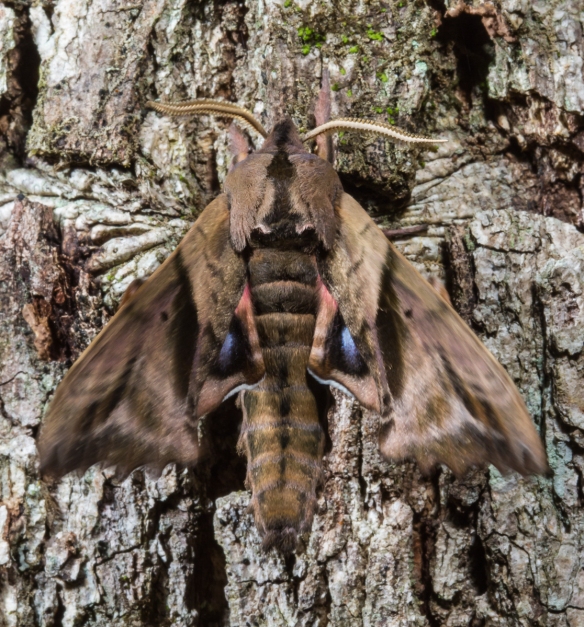…wings large and splendid, which were designed to bear a precious burden through the upper air.
~Henry David Thoreau commenting on a pair of moth wings floating down as a bird ate the moth
As National Moth Week comes to a close, I found a moth that I definitely wanted to share. I found it in a most unglamorous place – the window screen of a campground restroom in the mountains of Virginia. But the moth was a large and striking one, with an unusual set of wings.
As soon as I saw it, I gently placed my finger under it to allow it ti climb up so I could move it back to camp for some photographs. The moth cooperated and I admired its unusual scalloped wing edges as we walked back to the car and my camera. I placed it on a tree trunk and was impressed by how well its striking pattern suddenly blended in with the textures of tree bark. Looking in the moth field guide I had conveniently brought along showed this specimen to be the Blinded Sphinx, Paonias excaecata.
These are large, somewhat common, moths of open deciduous woodlands and are found throughout much of the United States and Canada. But, this was my first, so I spent several minutes photographing it from several angles. Its abdomen curled upward when viewed from the side, a pose I have seen in many other species.
Key features for identification include the black stripe down the middle, the wavy edge on the hind part of the fore-wings, the purplish cast to the upper portions of the body, and a black area on the hind wings containing a blue spot with no black spot in it. This blue spot on each hind wing is said to resemble an eye iris. The lack of a black spot (or pupil) in that iris makes this a “blind” sphinx (hence the common name), when compared to other species that contain a black spot. But, my moth was apparently shy, and I was having trouble getting it to show me its “eyes”.
I touched it a few times on the edge of its wings, blew on it, and all I got was it starting to climb the tree trunk and then the characteristic shaking that moths often do before taking off. Apparently, when they have been still for quite some time as was the case with my moth, they need to warm their flight muscles a bit before taking wing. The moth quivered (akin to us shivering when cold to warm up our muscles) for about a minute, and then zoomed off into the forest at the high rate of speed typical of Sphinx Moths, the fighter jets of the moth world. I got a quick shot of a bit of its beautiful eye spots, and you can see the blurring in the wings from the quivering. I’d say that was a fitting way to end National Moth Week. And I will continue to watch for and photograph them in the coming weeks, as they are an incredibly diverse and interesting group of organisms.





Thanks! Unrelated question: with my open eyes, this morning I spotted a “gang of daddy long legs” at the top of the plant, all sort of clustered together, though they become real active when I leaned in to take a pic with my iphone. What do you think was going on? Don’t see that I can attach my pic here, but there must have been at least a dozen, almost on top of each other until I disturbed them!
Hey Judith…I have seen that many times, often in cooler months as Autumn approaches. No one is quite sure why they do this but the two most common theories are: 1) the clusters create a more favorable micro-climate for them and, 2) it may help in predator defense. Daddy Long Legs secrete chemicals when disturbed and often bounce up and down (do push ups). The sight and smell (or taste) of a larger group may convince certain predators to try elsewhere for a meal.